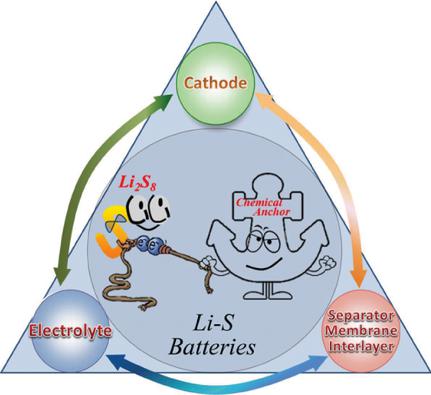当前位置:
X-MOL 学术
›
Adv. Mater. Interfaces
›
论文详情
Our official English website, www.x-mol.net, welcomes your feedback! (Note: you will need to create a separate account there.)
Sulfur Immobilization by “Chemical Anchor” to Suppress the Diffusion of Polysulfides in Lithium–Sulfur Batteries
Advanced Materials Interfaces ( IF 5.4 ) Pub Date : 2017-12-28 , DOI: 10.1002/admi.201701274 Zhipeng Zeng 1 , Xingbo Liu 1
Advanced Materials Interfaces ( IF 5.4 ) Pub Date : 2017-12-28 , DOI: 10.1002/admi.201701274 Zhipeng Zeng 1 , Xingbo Liu 1
Affiliation

|
Lithium–sulfur (Li–S) battery is considered to be one of the most promising contenders for the next generation high‐energy storages due to their high theoretical energy density (≈2600 Wh kg−1), which is nearly five times higher than that of the commercial LiCoO2/graphite batteries. However, a series of issues especially for the dissolution of lithium polysulfides (LiPSs) and their “shuttle effect” greatly limit their widely commercial applications. Starting from a brief overview of conventional methods to solve these problems, the achievements spotlighted in this review mainly show that the diffusion of LiPSs can be effectively suppressed by forming strong “chemical anchor” between LiPSs and host materials. The synthetic methods and characterization techniques are reviewed according to different types of chemical bonding between LiPSs and the host materials. Theoretical calculation methods are also summarized here to further understanding the role of these “chemical anchors.” Proposing with some perspectives and future research efforts, this review is hoped to provide an in‐depth understanding and offer avenues in the rational design of Li–S batteries with long cycle life and high energy/power density in the near future.
中文翻译:

通过“化学锚”固定硫以抑制锂硫电池中多硫化物的扩散
锂硫(Li–S)电池由于其高理论能量密度(≈2600Wh kg -1)而被认为是下一代高能存储最有前途的竞争者之一,其能量密度是后者的近五倍。商用LiCoO 2的/石墨电池。但是,一系列问题,尤其是多硫化锂(LiPS)的溶解及其“穿梭效应”,极大地限制了其广泛的商业应用。从对解决这些问题的常规方法的简要概述开始,本综述重点介绍的成就主要表明,通过在LiPS和主体材料之间形成牢固的“化学锚”,可以有效地抑制LiPS的扩散。根据LiPS与主体材料之间化学键的不同类型,综述了合成方法和表征技术。本文还总结了理论计算方法,以进一步了解这些“化学锚”的作用。提出一些观点和未来的研究工作,
更新日期:2017-12-28
中文翻译:

通过“化学锚”固定硫以抑制锂硫电池中多硫化物的扩散
锂硫(Li–S)电池由于其高理论能量密度(≈2600Wh kg -1)而被认为是下一代高能存储最有前途的竞争者之一,其能量密度是后者的近五倍。商用LiCoO 2的/石墨电池。但是,一系列问题,尤其是多硫化锂(LiPS)的溶解及其“穿梭效应”,极大地限制了其广泛的商业应用。从对解决这些问题的常规方法的简要概述开始,本综述重点介绍的成就主要表明,通过在LiPS和主体材料之间形成牢固的“化学锚”,可以有效地抑制LiPS的扩散。根据LiPS与主体材料之间化学键的不同类型,综述了合成方法和表征技术。本文还总结了理论计算方法,以进一步了解这些“化学锚”的作用。提出一些观点和未来的研究工作,



























 京公网安备 11010802027423号
京公网安备 11010802027423号